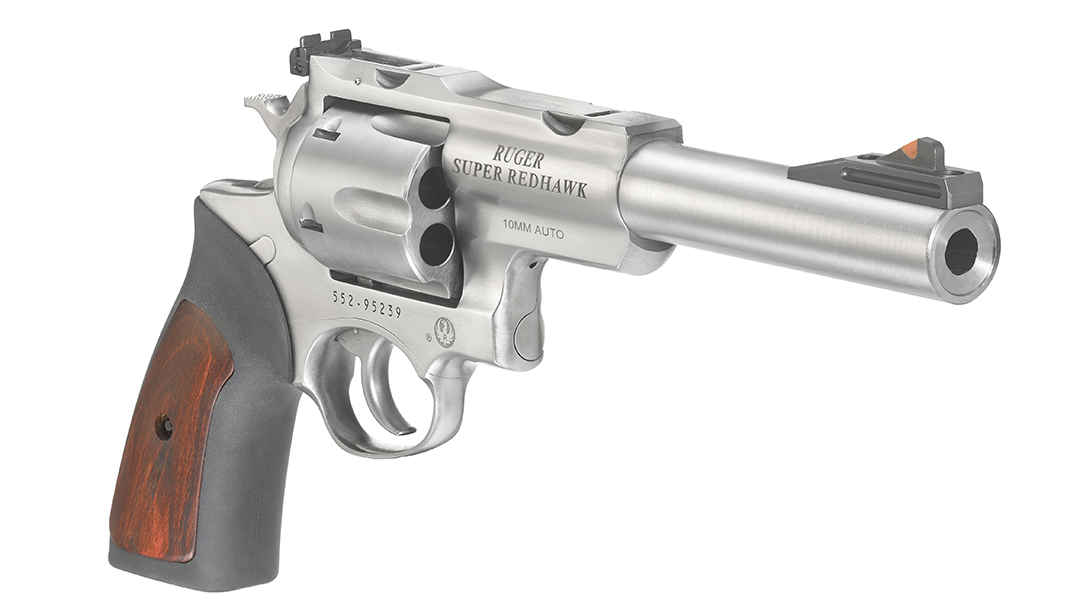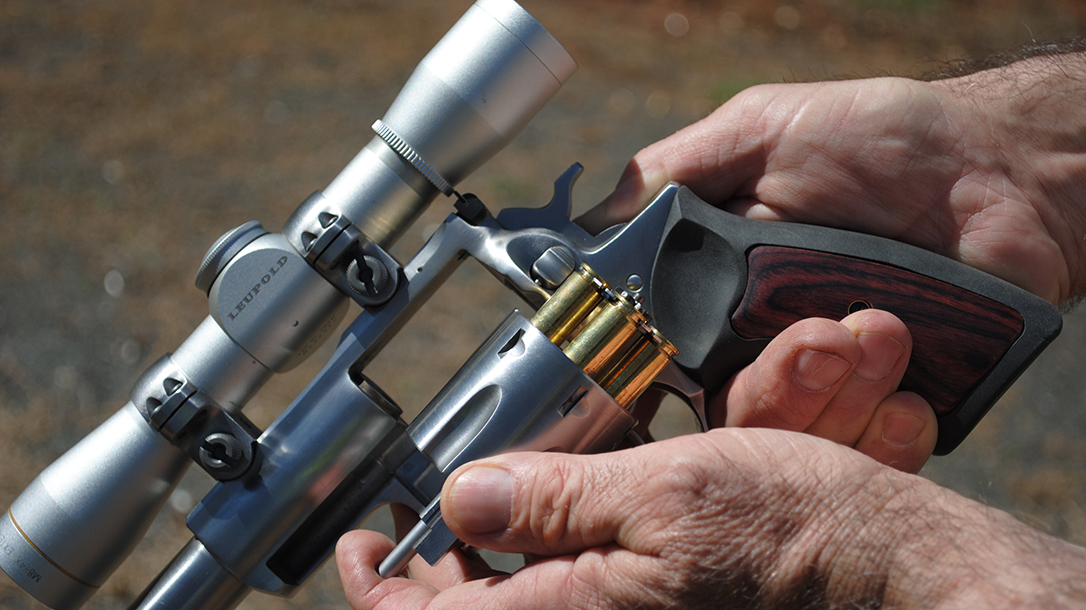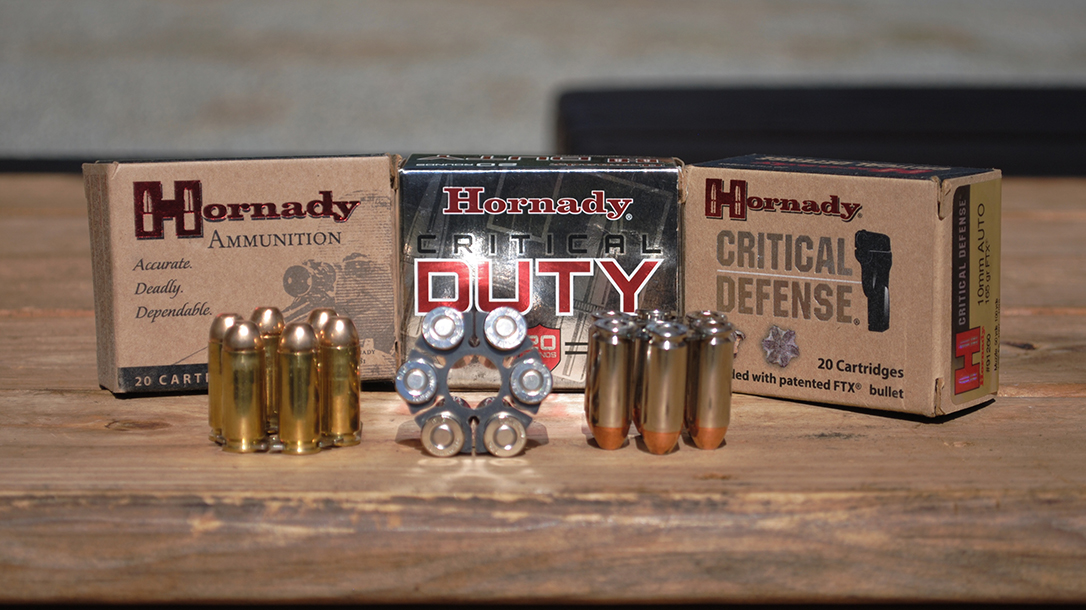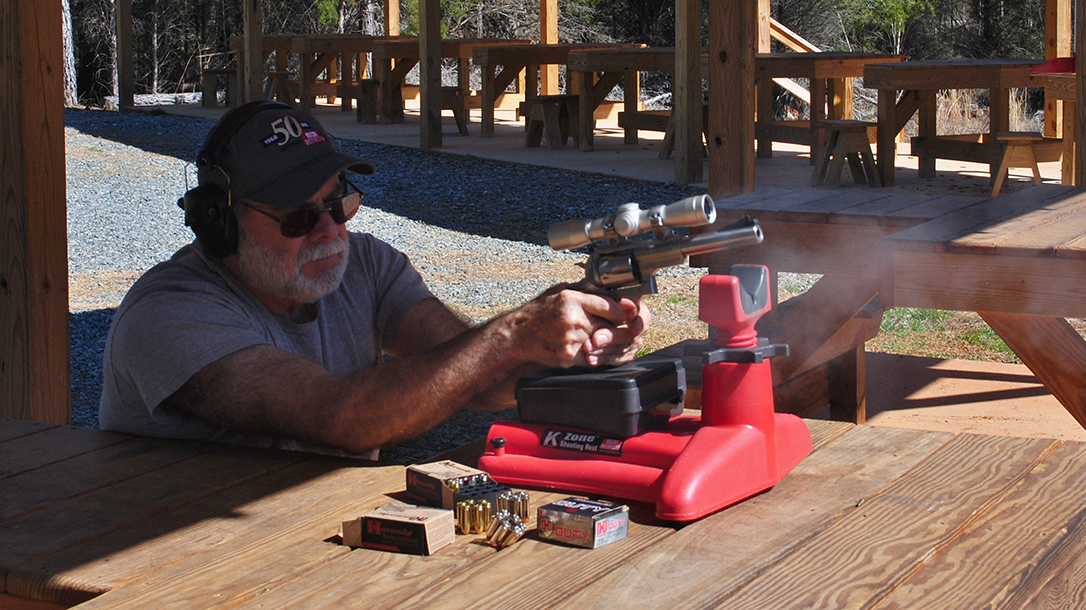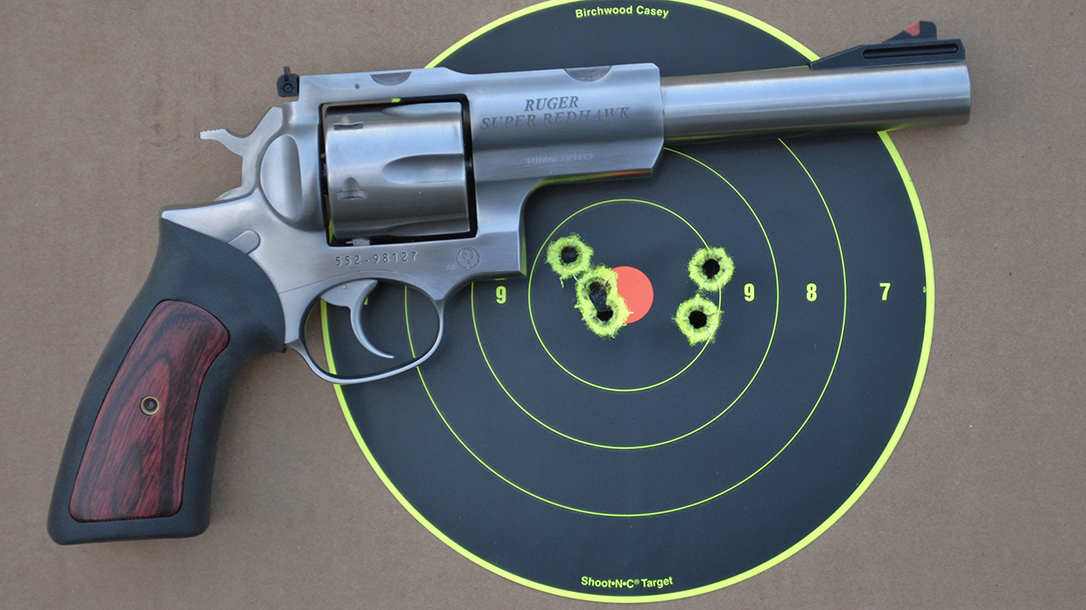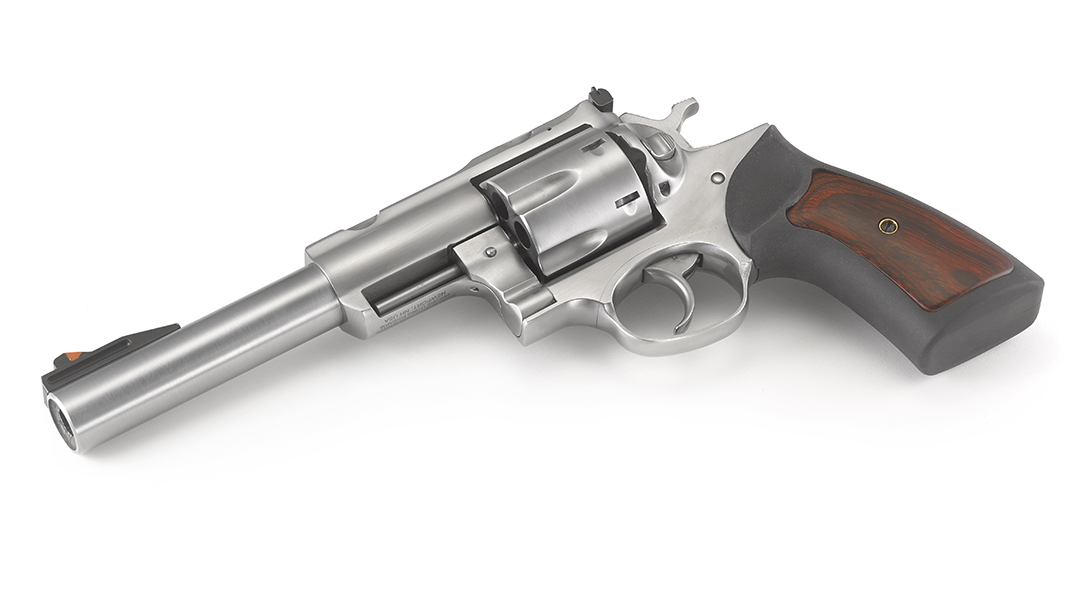Since August of 2017, I’ve tested a half-dozen 10mm Auto pistols. I’m not complaining. In fact, I’ve found the experience educational and entertaining, although my shooting hand was sometimes a bit sore afterwards.
But note what I wrote: a half-dozen pistols. In general, when you mention the 10mm Auto, most shooters envision a semi-automatic pistol chambered for that cartridge. As such, it gladdened my heart when I learned I would be testing a Ruger Super Redhawk 10mm revolver this time.
Advertisement — Continue Reading Below
Ruger Super Redhawk 10mm Going Full Circle
I cut my shooting teeth on double-action revolvers and have been an admirer of them ever since. My first handgun was a .22 LR revolver, and my first carry gun was a .38 Special. A .357 Magnum revolver accounted for the first deer I took with a handgun. Also, when I began competing in action pistol matches, I used a .45 ACP revolver. I have long agreed with my older brother—an avid shooter, sheriff’s deputy and engineer in the firearms industry—who says, “For the first six shots, a double-action revolver is the best handgun in the world.”
Ruger introduced its Super Redhawk line late in 1987, in .44 Magnum with 7.5- and 9.5-inch barrels. It differed from the earlier Redhawk revolver because it used the same trigger system as the popular .357 Magnum GP100 revolver (in fact, many of the parts are interchangeable between the revolvers) and a heavier frame with a strengthened topstrap and frame extension into which the barrel is threaded. This made for an extremely strong and well-supported barrel/frame interface and stiffened the barrel without the need for an underlug, as is the case with many magnum revolvers.
Locking Up The Ruger Super Redhawk 10mm
The Super Redhawk’s cylinder locks up at three points. First, the center pin on the end of the ejector rod enters a recess in the recoil plate. Then, a latch on the front of the cylinder crane engages a cutout in the frame extension. Finally, a heavy-duty bolt in the bottom of the frame engages notches in the cylinder to provide extra locking.
Advertisement — Continue Reading Below
Ruger also followed the beat of a different drummer with the cylinder release. Instead of pushing it forward (a la S&W) or pulling it back (a la Colt), you push it in, which forces the center pin forward while pulling the cylinder crane latch back. This lets you swing the cylinder out to the left. Pushing on the ejector rod extracts all six spent cartridge cases simultaneously.
The Ruger Super Redhawk was designed for use with a telescopic sight. Milled crescents are machined into the topstrap and frame extension, letting you attach steel scope rings that are supplied with each revolver. Rings clamp onto the revolver securely and stand up to the recoil of the heaviest revolver cartridges.
The Super Redhawk proved a commercial success. The platform eventually expanded with .41 Magnum, .454 Casull and .480 Ruger options joining the lineup.
Advertisement — Continue Reading Below
10mm Origins
This leads us to this new Super Redhawk chambering. In the late 1970s, police forces were switching from .38 Special/.357 Magnum revolvers to 9mm pistols, much to the consternation of the bigger-bullets crowd—those who believe you should never go into harm’s way with a handgun in a caliber that does not begin with a four.
Whit Collins proposed a medium-caliber cartridge that propelled a bullet of about 200 grains at 1,000 fps to provide the ballistic advantages of the 9mm and the fight-stopping ability of the .45 ACP.
Colonel Jeff Cooper lent his support to the idea and teamed up with Thomas Dornaus and Michael Dixon to develop such a cartridge. Dornaus and Dixon formed a company to manufacture a pistol based on the CZ 75, which they dubbed the “Bren Ten.” It was chambered for the new cartridge, baptized the 10mm Auto.
Advertisement — Continue Reading Below
Norma further developed the cartridge, but the product was considerably hotter than originally envisioned, propelling a 170-grain JHP to 1,300 fps and a 200-grain FMJ to 1,200 fps.
Manufacturing problems led to the demise of the Bren Ten, but through the years, several companies have produced 10mm pistols. For a brief time, the FBI used a S&W 10mm pistol but found its weight and recoil problematic. A few American police departments use 10mm pistols, and Denmark issues them to the Slædepatruljen Sirius (Sirius Sledge Patrol) in northeastern Greenland for defense against the polar bears that officers sometimes encounter during winter patrols.
10mm Performance
Some commercial 10mm loadings produce performance similar to the .41 Magnum revolver cartridge, which is why the current resurgence of interest in the 10mm is primarily among handgun hunters. It takes little imagination to deduce why Ruger’s marketing gurus came up with the idea of combining the popular Super Redhawk revolver with the newly popular 10mm Auto cartridge.
Advertisement — Continue Reading Below
The 10mm Super Redhawk is a member of a small but distinctive community—revolvers chambered for pistol cartridges. The first were the M1917 revolvers used by the U.S. Army during World War I, which used a pair of stamped-steel half-moon clips, each holding three .45 ACP cartridges, that allowed the extractor to eject the casings. With the burgeoning popularity of action pistol shooting in the 1970s, the full-moon clip was developed. It held six cartridges, allowing rapid reloads for shooters (including me) using .45 ACP revolvers in competition.
Benefits of Pistol Cartridges in Revolvers
I’m sure some of you wonder why Ruger would chamber a revolver for the 10mm when there are so many excellent revolver cartridges. But pistol cartridges provide several advantages for wheelgun shooters, the first of which is reloading speed.
Advertisement — Continue Reading Below
Pistol cartridges generally have shorter overall lengths than magnum revolver cartridges. When connected on a full-moon clip, they can be dropped into a revolver cylinder quickly and ejected faster than the longer cartridges traditionally used in revolvers. Another advantage is that the full-moon clip holds the spent cases together for reliable extraction and ejection, and a stray case cannot slip under the revolver’s extractor, jamming up the works.
As for cost, a perusal of websites shows that 10mm ammunition is cheaper than most .44 Magnum, .454 Casull and .480 Ruger rounds. Lastly—and this is of interest to reloaders—spent brass is easy to find and pick up.
So there you have it. The new Super Redhawk is chambered for a cartridge capable of taking large game with the advantages of more reliable ejection and faster reloading. What’s not to like?
Advertisement — Continue Reading Below
Ruger Super Redhawk 10mm Fit & Feel
The Ruger Super Redhawk sent me was the first of its kind I tested, and it’s an impressive revolver. When I picked it up, I was reminded of that famous line from Crocodile Dundee: “That’s not a knife. This is a knife.” Let me tell you, this is a revolver.
Although its 6.5-inch barrel provides excellent balance, I’ll wager that at 3.38 pounds unloaded, you won’t do much one-handed shooting with it. The muzzle is also crowned to protect the rifling from damage.
The fit, finish and quality of materials were excellent, but the double-action (DA) trigger stroke was rather heavy, and it took 6 pounds of pressure to trip the hammer in single-action (SA) mode. Since this was a brand-new revolver, I’m sure both will improve with use.
Advertisement — Continue Reading Below
At The Range With the Ruger Super Redhawk 10mm
Taking advantage of a mild February afternoon, my wife, Becky, and I headed to our gun club to see how the Ruger would perform. We measured the gun’s accuracy with four types of 10mm ammo by shooting targets at 20 yards from an MTM K-Zone rest. The Ruger shot to the point of aim out of the box and produced some impressive groups. However, it showed a preference for slower bullets, and group sizes opened up as velocities increased. Thankfully, its weight and hand-filling rubber grips made recoil extremely controllable.
After chronographing the ammo, I mounted a Leupold 4x28mm M8 scope on the Ruger, and it took about 10 rounds to zero. Pacing off what I figured was close to 40 yards, I set up a Birchwood Casey Pregame boar target. Returning to the firing line, I sent 10 rounds downrange. I don’t have lots of experience with scoped handguns, but by carefully placing the scope’s crosshairs on the target and nursing the trigger a bit, I placed nine shots of 10 in the target’s kill zone. Not too bad for the first time out, eh?
I believe Ruger’s new 10mm Super Redhawk would be well suited for taking deer-sized animals at moderate ranges. It would also be a viable choice for hunting guides, campers, rangers or homesteaders in regions where they might encounter dangerous animals. And if you happened to have a 10mm pistol in your gun safe already, you won’t have to buy or reload a new cartridge. For more information, visit ruger.com.
Ruger Super Redhawk 10mm Specs:
Caliber: 10mm
Barrel: 6.5 inches
OA Length: 12 inches
Weight: 54 ounces (empty)
Grips: Cushioned rubber
Sights: Ramp front, adjustable rear
Action: DA/SA
Finish: Satin stainless
Capacity: 6
MSRP: $1,159
Hornady 175 Critical Duty: 1,141 fps, 1.3 inches
Hornady 180 XTP: 1,162 fps, 1.5 inches
Sig Sauer 180 V-Crown JHP: 1,244 fps, 1.8 inches
Winchester 175 Silvertip: 1,258 fps, 2.3 inches
Bullet weight measured in grains, velocity in fps by chronograph and accuracy in inches for best five-shot groups at 20 yards.
This article is from the September/October 2018 issue of Combat Handguns Magazine. Grab your copy at OutdoorGroupStore.com.
